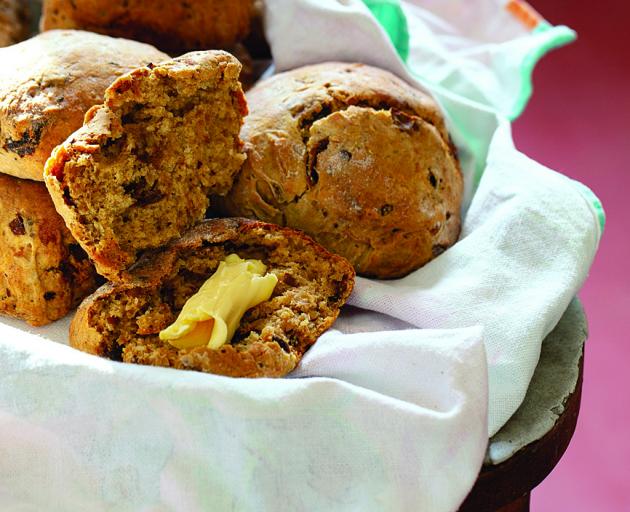
She has detailed her, husband Joe and their young daughters Flora and Evelyn’s life on the 40,000ha sheep and beef high-country station in a new book A High Country Life.
The book also includes some of her most trusted recipes.
A couple of years ago, she began sharing her recipes and experiences on instagram@whats_for_smoko as a way of connecting with others living in remote places.
The following is an edited extract from the book.

We often describe Otematata as a microclimate. In the middle of winter when the valleys that surround us are engulfed in hoar frost, we will be standing on the plateau under blue skies, the sun warming the backs of the shepherds and my washing drying before the temperature drops off in the afternoon. Seeing the sun and basking in its warmth and light are vital when the winter days are short. We are so very lucky to live here.
After a cold frost, which can plummet to temperatures of minus four, or when the southerly whips through with a wind chill temperature as low as minus eight, the sun will pour into my kitchen window and stretch its fingers into the lounge. Our German shorthaired pointer, Paige, will compete with the girls for the sunny spots, where they’ll curl up together with a book while I finish washing the breakfast and smoko dishes.
Just as winter settles in and the frosts become more frequent, we begin to think about the spring. Joe is heavily involved in pasture management on the property, and needs to ensure there will be enough feed grown to sustain our large breeding flock of merinos, the cattle and then the predicted number of lambs heading into the summer months.
We have around 11,000 ewes to scan in just four short days. The reason for such a condensed timeline is that every other farmer also requires the same services.
The scanner is one sought-after worker, and they have only a small window of opportunity to get around everybody’s farms.
The four days of ewe scanning are long and usually quite cold. The yards in which the portable ultrasound machine is set up are relatively sheltered, but there’s still frost underfoot. On these days I make sure there’s a warm morning smoko and a large filling lunch so everyone stays well-fed. The food is picked up from my kitchen in the early morning by the young shepherds, and so I’ve had to get creative as to how to keep the smoko warm for a few hours before it is eaten.

There is, of course, the obvious choice of hot soup in the thermos. I like to send along a thick and hearty vegetable soup. I make it the night before in the magic pot, using dried red lentils and barley in the mixture to thicken it up. In the morning it is steaming hot, and I pour it into the thermoses as I prepare the smoko bags. I tried pumpkin soup last year, but got a bit of grief when it solidified in the thermoses and was hard to pour.
Another ingenious idea, for which I owe credit to Joe’s cousin Erika, is to use a hot-water bottle. I place hot food like sausage rolls, bacon butties or little savouries in a metal cake tin, and then into an insulated bag with a filled hottie. This way the shepherds are able to enjoy a warm morning smoko while the frost still ices the ground.

Station brownie
This brownie is chewy and sweet, with a hint of caramel. It will keep in an airtight container for up to 10 days — provided it’s not devoured straight away!
MAKES 20 PIECES
125g butter
¾ cup brown sugar
¼ cup caster sugar
225g dried fruit
150g self-raising flour
1 egg, lightly beaten
Method
Heat the oven to 190degC fan-bake. Line a 28cm x 18cm brownie tin with baking paper.
Melt the butter in a pot. Add the brown sugar and caster sugar, and dissolve them into the butter.
Allow the mixture to cool, then add the dried fruit, flour and egg, and stir to combine. Pour the batter into the lined tin.
Bake for about 20 minutes until golden on top and firm to touch. You want the brownie crunchy on the outside and chewy on the inside.
Allow to cool before cutting into pieces.
Tips and tricks
This recipe is easily doubled. Use any dried fruit you like - a combination or just one kind. I often use raisins.

Soft and sweet date scones
I think date scones would have to be my favourite type of scone, and these ones are so good that they could even challenge what’s on offer in some of the trendiest cafes.
They are soft and sweet (as the name suggests), and are best sampled warm out of the oven with plenty of good-quality butter.
I like to cut them in half and butter each side, so that people can eat them straight from the tin while out mustering or in the smoko room.
MAKES 12
1 cup chopped dates
3½ cups self-raising flour
½ cup caster sugar (optional as the dates add sweetness)
1 cup cream
1 cup soda water
Method
Heat the oven to 200degC fan-bake. Line an oven tray with baking paper.
Place the chopped dates in a pot, and cover with water. Simmer on a low heat until the dates become soft.
Drain any excess water and let the dates cool as you prepare the scone mixture.
Add the remaining ingredients into a large mixing bowl (in the order listed). Gently bring together with a butter knife, then add the cooled dates.
Tip on to a well-floured surface, and sprinkle with more flour before shaping into a rectangle approx. 3cm high. (Use floured hands to avoid the dough sticking.)
Cut into a 4 x 3 grid to form 12 scones, and place on to the lined tray, packed tight with a gap of about 1cm between each one — this will help them to rise higher.
Pop in the oven for 12-15 minutes until golden brown.
Tips and tricks
If you don’t have self-raising flour, replace each cup with 1 cup of plain flour and 1½ teaspoons of baking powder.
As an alternative to sugar, you could add 2 tablespoons of honey to the dates while they are simmering.
Keep a stash of UHT cream in your pantry to use when you don’t have any fresh cream.
If you don’t have a SodaStream, use store-bought soda water or lemonade — but consider purchasing cans that can be recycled easily, rather than plastic bottles.
If you use lemonade, omit the sugar.
You could add orange zest to the dates as they simmer for a burst of citrus flavour.
Scone dough doesn’t like to be played with too much. If you use a cutter, make sure to keep your waste to a minimum so that you’re not constantly reworking the dough scraps.
All ovens are different, and the timing may change depending on your scone size. Keep an eye on them - they may need a little longer.

Picnic pie
This is very similar to a bacon and egg pie, but it’s a great way to use up any sausages or sausage meat you may have lingering in your freezer. The sausage meat adds a different texture and is quite filling.
MAKES 1
(8-12 SLICES)
400g block puff pastry
12 eggs
salt and pepper
500g sausage meat
egg wash or a little milk (optional)
Optional additions
leftover cold new potatoes, or parboiled potatoes cut into chunks
tomatoes
spinach
silverbeet
grated zucchini
spring onions
tomato relish
cheese
Method
Heat the oven to 180degC fan-bake. Set aside a 32cm x 25cm pie dish.
Use a knife to mark thirds in the pastry block. Roll two-thirds of the pastry out and use it to line your pie dish, making sure the pastry goes up the edges.
Trim any excess away. Roll the final one-third out and cut into long strips to be used as a lattice to top the pie with later.
Break the eggs into your dish and use a clean hand to break the yolks up. (I use my hand so that I don’t accidentally pierce the pastry with my fork.)
Alternatively, if you prefer your yolks whole, leave them alone. Season with salt and pepper.
Squeeze the sausage meat in little dollops throughout the pie and add any optional extras. Use the strips of pastry to criss-cross your pie to create a lattice. Trim any excess away from the sides. Brush the pastry with egg wash or a little milk if you want a golden top.
Bake for 20-25 minutes.
Tips and tricks
You can use as many eggs as you like; a dozen is just a nice round number that I like to use. It won’t make much of a difference if you use 10 or 12 or 14!
If you don’t have sausage meat, use sausages and squeeze the meat out of the casings.
The lattice strips don’t have to be the same size; it looks nice and rustic when they are different sizes.
Comments
Dear Philippa,
I made the Station Brownie using half sultanas and half raisins (only because small amounts of each was what I had in the pantry) and our household eagerly consumed it within 48 hours! It was such a success that I've since made an all sultana one and a date one. It'll be interesting to see how long they last. Thank you so much for such a great easy recipe. Am looking forward to trying the date scone and picnic pie recipes. If they turn out as good as the station brownies, I'll be the most popular person at home for a long time to come.











